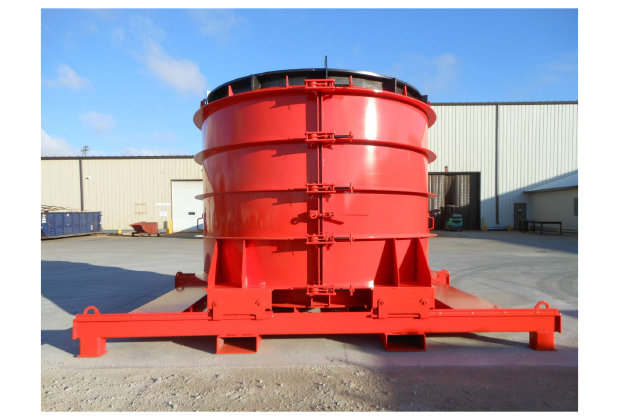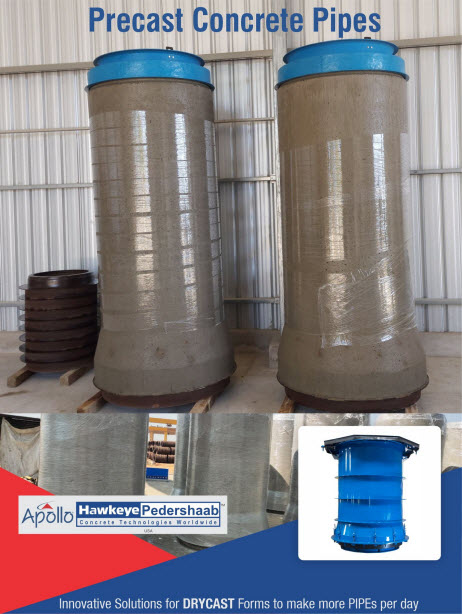
Concrete pipes are essential for many infrastructure projects, including stormwater management, sewage systems, and drainage applications. One of the most efficient ways to manufacture concrete pipes is through the drycast pipe mould process. This method involves using stiff, zero-slump concrete that can be immediately demoulded and used. The drycast process is particularly popular for large-scale production because of its speed and precision. In this guide, we'll walk through each step of the drycast pipe mould production process, from material preparation to final curing.
Step 1: Material Preparation
The first step in producing concrete pipes using the drycast method involves preparing the materials. The primary materials used include:
- Cement The binding agent that forms the concrete.
- Aggregates: Gravel, sand, or crushed stone, which provide strength and durability.
- Water: Used in minimal quantities to form the stiff, no-slump mixture.
Proportioning the Mix
Accurate proportioning of materials is critical for ensuring the strength and durability of the final product. The water-to-cement ratio in the drycast process is much lower compared to other methods like wet cast, resulting in a stiff mixture that can hold its shape without collapsing.
Step 2: Preparing the Concrete Pipe Mould
Before starting the casting process, it is essential to prepare the concrete pipe mould. Mould preparation includes:
- Cleaning the Mould: Ensuring the mould is clean and free from any residual concrete from previous production cycles is crucial to avoid imperfections in the final product.
- Lubricating the Mould: Applying a release agent or mould lubricant prevents the concrete from sticking to the mould, making it easier to remove the pipe after casting.
Pipe mould manufacturers have developed durable and high-quality pipe moulds that ensure uniformity and precision across each casting.
Step 3: Filling the Mould with Concrete
Once the materials and mould are ready, it's time to fill the pipe mould with the prepared concrete mixture. In the drycast process, the mixture is placed into the mould without the use of pouring. Instead, specialized equipment compacts the stiff mixture.
Vibration and Compaction
The drycast method relies on inner core vibration and hydraulic pressing to ensure the concrete is adequately compacted. This step ensures there are no air pockets or gaps in the pipe walls, which could weaken the final product. Pipe mould equipment often fixed with the most advance core vibrator to ensure consistent compaction.
- Vibrating the Mould: Vibration is applied to the mould from the inside, ensuring the stiff concrete settles uniformly and fills all voids.
- External Vibrators: Some systems also use external vibrators to ensure even distribution of the mixture, especially in larger diameter pipes.
Step 4: Immediate Demoulding:
One of the key advantages of the drycast method is the ability to immediately demould the concrete pipe once the mixture has been compacted and formed. Unlike wet cast methods, which require time for the concrete to set and harden in the mould, drycast concrete has enough stiffness to be removed from the mould right after compaction.
- Demoulding Process: WThe mould is opened, and the newly formed concrete pipe is carefully extracted. Because of the minimal water content, the pipe retains its shape and can be handled without the risk of collapse.
This immediate demoulding process is what allows for the rapid production rates often associated with drycast pipe moulding.
Step 5: Curing the Concrete Pipe
While the drycast method allows for quick demoulding, the concrete pipes still need to undergo proper curing to achieve full strength and durability. Curing with polythene covering helps the concrete continue its hydration process, improving its compressive strength over time. Afterwards water spraying.
Accelerated Curing Methods
Some manufacturers use accelerated curing techniques, such as steam curing or heating chambers, to speed up the process. These methods can help reduce the overall production time while ensuring the pipes meet the necessary strength requirements.
- Steam Curing: Steam is used to keep the moisture levels in the pipe consistent while raising the temperature, which accelerates the hardening process.
- Heated Curing Chambers:Similar to steam curing, these chambers create a controlled environment that enhances the rate of curing.

Step 6: Quality Control and Testing
Once the concrete pipes are cured, they undergo rigorous quality control and testing to ensure they meet industry standards. Common tests include:
- Strength Testing: Ensures the pipes can withstand the pressures they will face in the field.
- Hydro Testing:Ensures the pipes can sustain the hydrostatic test pressure.
- Dimensional Accuracy:Verifying that the pipes are within the specified tolerances for size and shape.
- Surface Finish Inspection: Ensuring that the pipe surface is free from major imperfections or cracks.
High-quality pipe mould equipment and strict quality control processes help Pipe mould manufacturers produce pipes that meet or exceed industry standards for performance and durability.
Step 7: Storage and Delivery
Once the pipes pass all quality checks, they are ready for storage or immediate delivery to construction sites. Proper handling and storage conditions are critical to ensure the pipes remain in optimal condition until they are installed.
- Storage:Pipes should be stored on flat, stable surfaces to prevent any warping or damage.
- Handling:Careful handling during transportation is essential to prevent cracks or other structural damage.
Advantages of the Drycast Pipe Mould Process
The drycast process offers several advantages over other methods of concrete pipe production, including:
- High-Speed Production: The ability to demould immediately after casting allows for a high turnover, making this method ideal for large-scale production.
- Lower Labor Costs: The high level of automation in the drycast process reduces the need for manual labor, cutting down on production costs.
- Consistent Quality: Automated systems ensure that each pipe produced is uniform in size and quality, making the drycast method highly reliable for large infrastructure projects.
- Durability:The compacted, stiff mixture results in dense, durable concrete pipes capable of withstanding heavy loads and harsh environments.
Limitations of the Drycast Pipe Mould Process
While the drycast process is highly efficient, it does have some limitations:
- Surface Finish: Drycast pipes tend to have a rougher surface compared to wet cast pipes, which may not be ideal for applications where aesthetics are a concern.
- Limited Shape Complexity: The drycast method is best suited for simple, repetitive shapes like cylindrical pipes. Complex shapes or detailed designs may be difficult to achieve.
Conclusion
The drycast pipe mould production process is an efficient and reliable method for manufacturing high-quality concrete pipes. From the initial preparation of materials to the final curing stages, each step is designed to maximize productivity while maintaining the integrity and durability of the finished product. With the right pipe mould equipment and careful attention to detail, manufacturers can produce large volumes of concrete pipe moulds that meet the strict demands of modern infrastructure projects.
FAQs About Drycast Pipe Mould Production
The primary advantage is the high-speed production due to the ability to immediately demould the concrete pipes, allowing for multiple pipes to be produced daily.
The drycast process uses minimal water and compacts the concrete with vibration, allowing for immediate demoulding, whereas the wet cast process involves a higher water content and longer curing times.
Yes, drycast pipes are highly durable and suitable for most infrastructure applications. However, they may not have the smooth surface finish of wet cast pipes.
Drycast is best suited for simple, repetitive shapes. Complex or custom designs may require the wet cast process.
Drycast concrete pipes are commonly used in drainage systems, culverts, and sewage lines where large-scale production and durability are essential.
Recent Articles
- Precast Concrete Box Culvert for Urban Underpasses and Cable Trenches
- How Concrete Pipe Machines Crucial in Power Plant Infrastructure?
- Role of Concrete Pipe Machines in Canal Lining Projects
- How Drycast Technology is Changing the Concrete Pipe Industry?
- Common Mistakes to Avoid When Selecting Pipe Moulds for Your Machine





 BACK TO ARTICLES
BACK TO ARTICLES